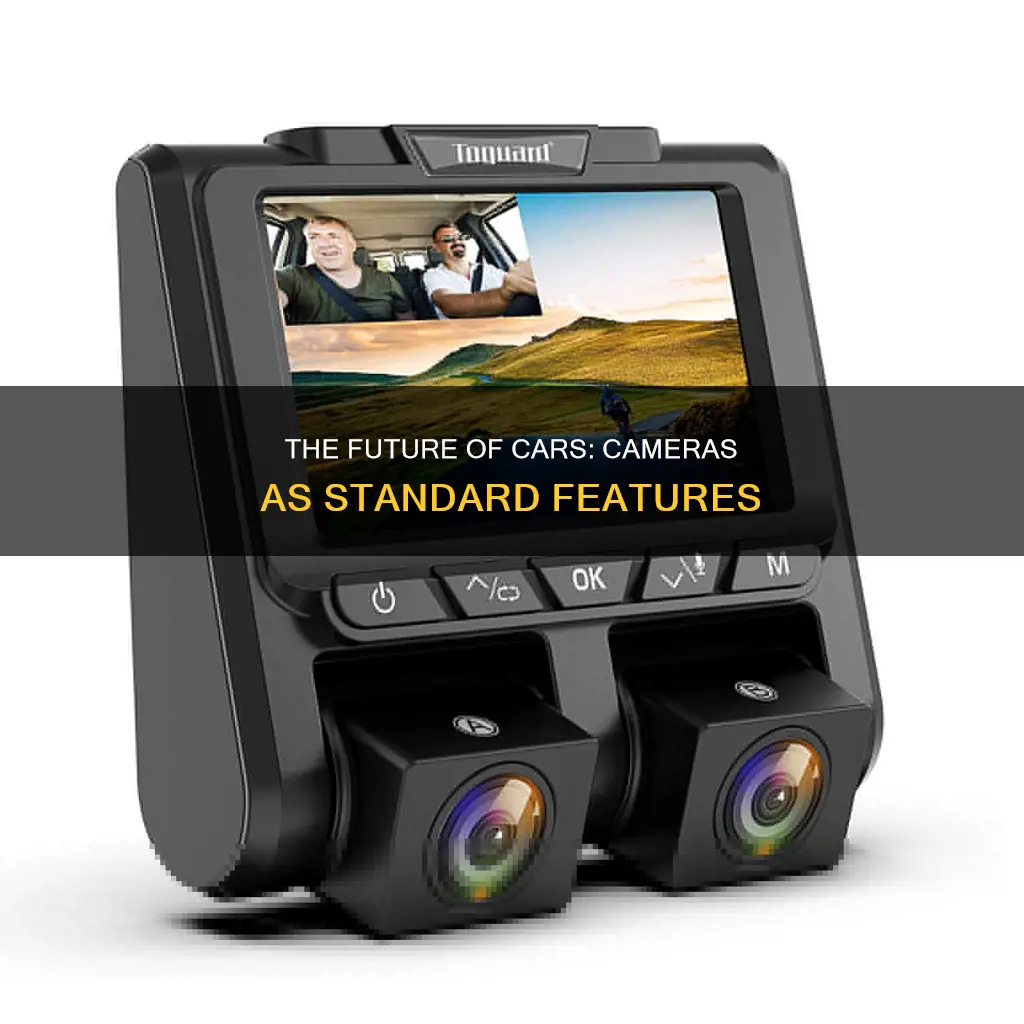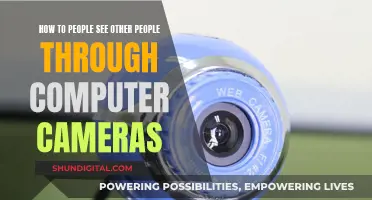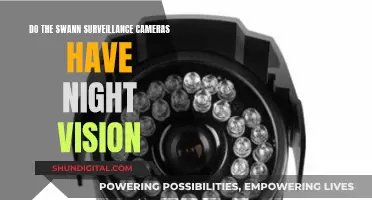
Cars with cameras are becoming increasingly common, with some vehicles offering both in-car and exterior monitoring systems. While dashboard cameras are commonly used in police cars and other emergency vehicles, personal vehicles are also increasingly being fitted with dashcams. In addition to external cameras, some car manufacturers are now installing cameras inside cars. These in-car cameras are used for a variety of purposes, including improving vehicle security, safety, and convenience, as well as enabling autonomous driving features. While some people may be concerned about the privacy implications of car cameras, others view them as a useful tool for protection and evidence collection in the event of an accident or insurance dispute.
| Characteristics | Values |
|---|---|
| Purpose | Blindspot assistance, parking assistance, autonomous driving, driver monitoring, security, etc. |
| Location | Outside the vehicle, inside the vehicle, rearview mirror, dashboard, steering column, etc. |
| Features | 360-degree visibility, facial recognition, ultrasonic sensors, GPS, WiFi connectivity, etc. |
| Benefits | Improved safety, convenience, and security; protection from dishonesty and false accusations; admissible as evidence in court |
| Concerns | Privacy, data collection, and potential misuse of footage |
What You'll Learn

Dashcams are increasingly being installed in personal vehicles
Dashcams are available from aftermarket manufacturers such as Garmin, Nextbase, Nexar, and Thinkware. They can be purchased for between $200 and $500 and are often installed in tandem with business vehicles. Installation takes around two to four hours and involves running wires to the camera for power and fixing it in place.
Automakers are also beginning to include dashcams as a factory-installed feature. BMW, for example, offers the Drive Recorder, which in the case of an accident, automatically saves a recording from 20 seconds before to 20 seconds after impact. The driver can also manually activate the recording. Toyota offers a dashcam as an option on several of its models, including the Sienna Hybrid, Venza, Prius, and RAV4. The camera is activated by G-force sensors and can be manually activated to record events of interest.
While factory-installed dashcams don't rival the recording capabilities of aftermarket models, they can still serve important roles for drivers. For instance, Toyota's system offers Parking Surveillance, which is activated if G-force sensors detect an impact or someone leaning on the vehicle. Accident Detection Mode uses G-force sensors to automatically protect footage before, during, and after an incident.
As the global automotive camera market is expected to almost double in the next six years, it is clear that dashcams are becoming an increasingly sought-after feature for motorists.
Arri Cameras: Where Are They Manufactured and Assembled?
You may want to see also

Cameras can be used to improve vehicle security and safety
Car cameras are becoming increasingly common, with many new vehicles offering in-car and exterior monitoring systems. While some may view this as an invasion of privacy, there are several ways in which cameras can be used to improve vehicle security and safety.
One of the most significant benefits of car cameras is their ability to enhance security by deterring crime and assisting in evidence collection. For example, security cameras in parking lots can help prevent vehicle damage, break-ins, theft, and assault. They can also provide valuable footage to identify perpetrators and assist in investigations, making it easier to bring them to justice. Additionally, with advancements in technology, parking lot security cameras can now be accessed remotely, enabling real-time monitoring and a quick response to any incidents.
Cameras can also improve road safety by helping to enforce traffic rules and reduce accidents. For instance, speed cameras have been shown to lead to a significant reduction in fatal and serious injury crashes, with studies reporting decreases ranging from 11% to 44%. Similarly, red-light cameras can capture vehicles that run red lights or stop signs, while bus lane cameras can monitor unauthorized use of dedicated lanes. These cameras can be linked to automated ticketing systems, helping to enforce traffic rules and promote safer driving.
In-car monitoring systems can also enhance safety by analyzing the driver's state and behaviour. For instance, some cameras use AI technology to determine if a driver is intoxicated or exhibiting risky behaviour. Additionally, cameras that monitor the driver's awareness can help prevent accidents caused by distracted driving.
Furthermore, cameras can provide assistance with parking and manoeuvring. Backup cameras, for instance, are now required on all new cars sold in the US to help drivers avoid accidents while reversing. Additionally, cameras that provide a bird's-eye view of the vehicle's exterior can improve safety by eliminating blind spots.
While car cameras offer several security and safety benefits, it is important to consider privacy concerns. Car manufacturers should ensure that data collected from these cameras is handled securely and in accordance with privacy policies, giving users control over their information.
Blocking Surveillance Cameras: Effective Methods to Ensure Privacy
You may want to see also

Some car cameras use AI to determine mood or intoxication
The use of cameras in cars is becoming increasingly common, with cameras being used both inside and outside vehicles. While some cameras are used to provide blind spot assistance or help with parking, others are being utilised to collect data and monitor drivers' behaviour and emotional states.
Some car cameras now use AI technology to determine a driver's mood or level of intoxication. For example, Affectiva, a startup from the MIT Media Lab, has developed emotional AI software that can track facial expressions and emotions like joy, anger, and surprise. The system also listens for sounds of anger, arousal, and laughter, and monitors yawning, eye closing, and blinking patterns to detect sleepiness. This technology could potentially be used to prevent accidents caused by drowsy or distracted driving, although it does raise concerns about privacy and data collection.
In addition to monitoring mood, car cameras with AI can also be used to detect drunk driving. Researchers at Edith Cowan University in Australia have developed an AI algorithm that can identify signs of intoxication, such as bloodshot eyes, flushed face, and droopy eyelids. The algorithm was tested on volunteers using an indoor driving simulator, and it was found to be 75% accurate in determining levels of intoxication. The system could potentially be integrated into smartphones or used in surveillance cameras installed on roadsides to prevent drunk driving.
While some people may welcome these technological advancements as a way to improve road safety, others may have concerns about the potential for privacy invasion and data misuse. It is important for car manufacturers to balance the benefits of these technologies with the need to protect the privacy and security of their customers. As the use of car cameras and AI continues to evolve, it is crucial to have clear regulations and policies in place to address these concerns.
Monitoring Surveillance Cameras Remotely: A Comprehensive Guide
You may want to see also

Cameras can help cars drive autonomously
In recent years, there has been a growing demand for hi-tech, onboard cameras in cars. These cameras can serve multiple purposes, from improving vehicle security and safety to enabling autonomous driving. While some companies and scientists believe that autonomous driving will be achieved through camera input alone, others argue that a combination of camera and Lidar technology is necessary for safe and effective self-driving cars.
Cameras in cars can provide a variety of benefits that support autonomous driving. One of the main advantages is that cameras can help the vehicle "see" its surroundings. This includes providing a better view when backing into parking spaces, offering blindspot assistance, and enabling the car to detect objects in its path. Additionally, cameras can be used for facial recognition software to analyze the driver's face and behaviour to combat drunk driving.
Tesla is at the forefront of the camera-only movement for self-driving cars. The company has been collecting vast amounts of video and vehicle data from millions of cars worldwide, using neural networks and camera input to estimate depth, velocity, and acceleration. Tesla's approach involves creating a training dataset of one million 10-second videos in different road, weather, and lighting conditions. This data is used to train deep learning models and develop advanced architecture for processing video input from multiple cameras.
However, one of the limitations of relying solely on camera technology is the challenge of performing well in different weather and lighting conditions. Even night-vision and high dynamic range-enabled cameras sometimes struggle with nighttime tasks. Additionally, processing the large amount of data from cameras can be computationally intensive, requiring a lot of processing power to extract meaningful information.
While the debate between camera-only and multi-sensor approaches continues, it is clear that cameras play a crucial role in helping cars drive autonomously. As technology advances and more data becomes available, we may see a shift towards fully autonomous driving, with cameras being a key enabler of this future.
The Evolution of Traffic Cameras: Computer-Operated Origins
You may want to see also

Some manufacturers allow users to disable cameras
In-car cameras are becoming increasingly common, with some vehicles now featuring cameras both internally and externally. While some cameras are mandatory, such as the rearview cameras now required on all new cars sold in the U.S., some cameras can be disabled by the user.
Some car manufacturers, such as Tesla, give users the option to disable cameras via the touch screen display. For example, the Tesla Model 3 features a camera above the rearview mirror, which can be covered with a sliding panel. Similarly, the 2020 Hyundai Sonata features five cameras, four of which are external, and the 2019 BMW X5 SUV has an optional driver-monitoring camera. These cameras can be deactivated through the system setup on the touch screen display.
In addition to disabling cameras, some manufacturers allow users to opt out of data sharing. For example, Toyota allows users to opt out of its Connected Services, although this may affect certain services. However, opting out of data sharing does not guarantee that data will not be collected or shared with third parties. As such, some users have taken additional steps, such as pulling the fuse for the Data Communication Module (DCM) to prevent data transmission.
While in-car cameras can offer benefits such as improved safety and convenience, they also raise privacy concerns. Users should review their car's data policies and privacy settings to understand their options for disabling cameras and opting out of data sharing.
Diorama Mode: Creative Camera Setting for Miniature Effect
You may want to see also
Frequently asked questions
No, but in 2018, onboard cameras were at the top of motorists' wishlists, and car manufacturers are increasingly integrating them into their vehicles.
Cameras in cars can improve vehicle security, safety, and convenience. Some cameras help eliminate blind spots, while others are installed to combat drunk driving by analyzing the driver's face and behaviour.
Cars, trucks, and SUVs from manufacturers like Hyundai, BMW, Tesla, and Kia have cameras. Dashboard cameras are also commonly used in police cars and other emergency vehicles.
Yes, you can usually disable cameras in your car through the touchscreen display or by sliding a panel to cover the lens.







